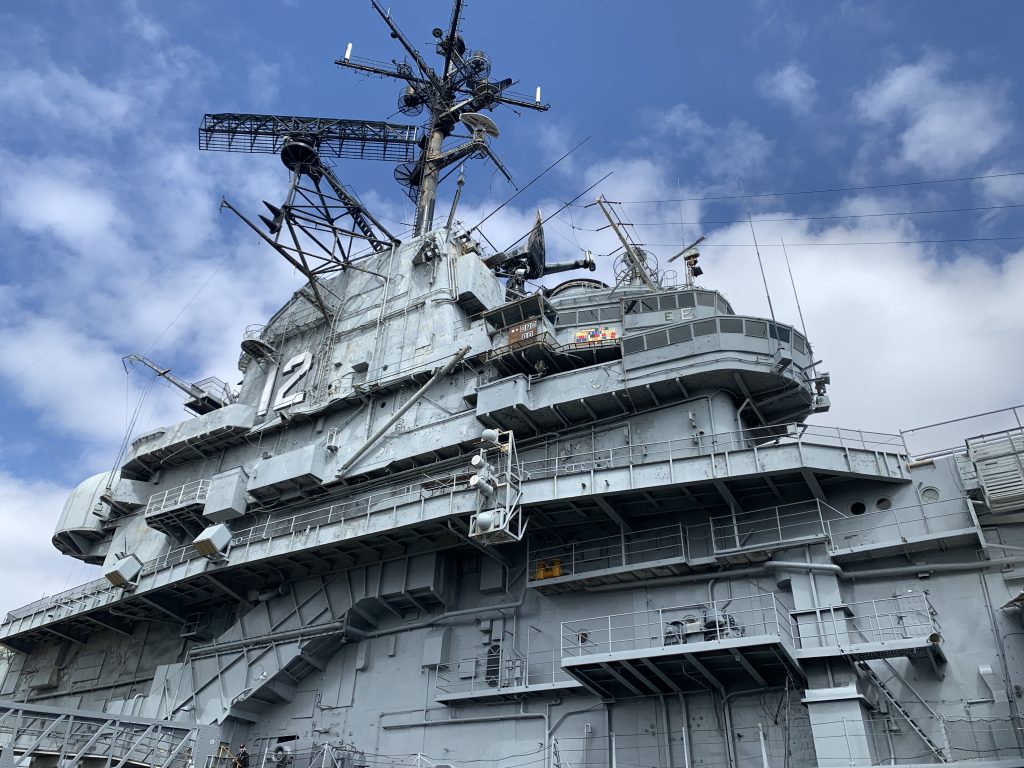When you board the USS Hornet, or CV-12 as it’s listed in U.S. Navy annals, you can still sense the tension and the buzz of activity that took place on the ship eight decades ago. The USS Hornet was a prime-time player in the War in the Pacific, and now, as a national historical landmark, it’s a showcase of America’s might and determination to win World War Two.
A few years ago, Ann and I boarded the USS Hornet to enjoy an evening of dancing and crooning by the Glen Miller Band. We had the time of our lives as we hit the dance floor to the Big Band sounds and took photos with the USO girls. While we loved our time on the Hornet, neither of us realized how much of a treasure the big ship is to the Bay Area and America.
This year we took the entire family to visit the USS Hornet Museum and made instant friends with many of the docents onboard. After hearing just tidbits of information about the ship, we knew immediately that we needed to commemorate the memory of Hornet through documentary-style video interviews and this brief overview.
Bill Miklos outlined the Apollo 11 mission and the Battle of the Philippine Sea. Don Tabb showed us around the flight deck as he recounted the accomplishments of the Hornet and its crews. Tom Constable reminisced about his dad’s commitment to the Navy and even loaned his leather flight jacket to Ann. Chuck Myers put everything into focus and outlined many of the heroic feats on Hornet. Our thanks go to Russell Moore and Keith Hedley, who helped greatly to coordinate and support our shoot.
CV-12 replaced CV-8, which was lost in the Battle of the Santa Cruz Islands in late 1942. CV-8 was the launching pad for the Doolittle Raid that sent a squadron of B-25 bombers over the skies of Tokyo on a mission that shocked the Japanese Imperial government.
Amazingly, it only took 16 months for the new Hornet to be constructed in Newport News, Virginia and sent out west to the Bay Area. After being commissioned in 1943, the Essex class Hornet immediately became a difference maker for the U.S. Fast Carrier Task Force, the business end of the spear for the Navy during the Pacific War.
Depending on the command structure of the moment, Hornet was either part of Task Force 38, under the command of Admiral William Halsey, or Task Force 58, under the command of Admiral Raymond Spruance. No matter the moniker, the Pacific fleet was under the overall command of Admiral Chester Nimitz as it sailed further west in its mission to destroy the Imperial Navy.
Hornet and its task force kept the pressure on the Japanese Navy, eventually wearing the previously formidable fleet down to non-factor status. The Hornet provided constant air support to protect the invasion beaches in New Guinea, then deployed a massive air attack on Japanese bases in the Caroline Islands. From there, Hornet was there to support the amphibious assault on the Marianas Islands.
Hornet never let up on the battered Japanese fleet. On June 11, 1944, the ship launched raids on two tiny islands that seemed insignificant at the time but were eventual keys to victory: Tinian and Saipan. The assault continued the following day as the Hornet moved into position to unleash heavy bombing attacks on Guam and Rota.
Three days later, the Hornet blasted Japanese airfields at Iwo Jima and Chichi Jima to protect U.S. Marines from air attacks while landing on Saipan. Things got much worse for the enemy on June 18th, as the Fast Carrier Task Force intercepted the Japanese Fleet, which was heading through the Philippine Sea bound for Saipan. The Battle of the Philippine Sea began the next day when Hornet launched strikes to destroy as many land-based Japanese planes as possible.
Hornet was decommissioned in 1970 and designated as a National Historic Landmark. It opened to the public as the USS Hornet Museum in 1998. Hornet has been featured in several film and television shows and is one of the most treasured museums in the San Francisco Bay Area.
The flight deck offers impressive views of “The Island,” the ship’s tower where command decisions were made, and flight operations were orchestrated by the Air Boss. You can also count on an impressive display of the San Francisco skyline, not to mention a biting wind that comes in off the San Francisco Bay.
The hanger bay is the showcase of the Hornet experience, with World War II planes arrayed side-by-side with more modern Navy jets, helicopters, simulators and Apollo 11 memorabilia. This part of the ship alone, which includes monthly displays honoring various war heroes and events, is worth a full membership.
As you work your way down to other levels of the Hornet, you’ll find the mess hall and hospital that handled the needs of more than 3,000 sailors. This was their home for the duration, and while it wasn’t the Ritz Hotel, they did have Ritz crackers in the store.
Chuck Myers took us way down into the lower confines of the ship, where he showed us the massive engine room that powered Hornet. It’s an engineering marvel, not only in the 1940s era but still today. Make sure you add this to your Hornet tour.
Keep a lookout for our video interviews with Chuck, Bill, Tom, Don, Russell and Keith as they trace the service life of USS Hornet, including the race across the Pacific, the Battle of the Philippine Sea and its role as the recovery ship for the Apollo astronauts returning from the Moon. I’ll also add our Hornet photo collection to the Gallery section so you can explore the ship’s inner workings with us. Our humble effort is to honor those who served onboard and salute those who carry on the Hornet legacy today.

